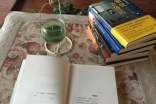关于夫妻相爱的英语作文(一)
关外国和中国结婚习俗的英语文章
Wedding Ring
The wedding ring has been in evidence. Some believe the wedding ring was the first element of wedding traditions. The circular shape of the wedding ring symbolizes never-ending love. Third finger, left hand It is believed that the vein in the third finger of the left hand runs directly to the heart.
Wedding Flowers
Historically, flowers & herbs have played a significant role in the attraction of "good" and/or the warding off of "evil". Greeks used ivy for the sign of lasting love. Today, pretty wedding flowers convey a message of fertility and enduring love and romance.
The minister will speak
To Groom:_ Do you take this woman to be your wedded wife, to live together after God's ordinance, in the holy estate of marriage _ Will you love her, comfort her, honor, and keep her, in sickness and in health; and, forsaking all others, keep yourself only unto her, so long as you both shall live _ (Groom: "I do.")
To Bride: Do you take this man to be your wedded husband, to live together after God's ordinance, in the holy estate of marriage _ Will you obey him and serve him, love, honor, and keep him, in sickness and in health;_ and, forsaking all others, keep yourself only unto him, so long as you both shall live _ (Bride:_ "I do.")
(Minister takes the bride by the right hand & taking the groom by the right hand, brings the hands together and instructs the couple to join hands.)
美国人的婚礼
Weddings in the United States vary as much as the people do. There are church weddings with a great deal of fanfare; there are weddings on mountain-tops with guests barefooted; and there have been weddings on the ocean floor with oxygen tanks for the guests. But many weddings, no matter where or how they are performed, include certain traditional customs.
美国的国土上居住着各种各样的人,他们的婚礼也千差万别.有热闹庄重的教堂婚礼;有在山顶上举行的婚礼,客人们光着脚陪伴登高;也有在海底举行的婚礼,客人们戴着氧气罐跟着入水.但婚礼无论在哪儿举行或怎样举行,总有某些传统的风俗.
Before a couple is married, they become engaged. And then invitations are sent to those who live nearby, their close friends and their relatives who live far away. When everything is ready, then comes the most exciting moment.
在举行婚礼前先要先订婚,然后发放请贴给住在附近的人和好朋友以及远方的亲戚.当一切准备就绪,就该到最激动人心的时刻了.
The wedding itself usually lasts between 20 and 40 minutes. The wedding party enters the church while the wedding march is played. The bride carrying a bouquet enters last with her father who will "give her away". The groom enters the church from a side door. When the wedding party is gathered by the altar, the bride and groom exchange vows. It is traditional to use the words "To have and to hold from this day forward, for better, for worse, for richer, for poorer, in sickness and in health, to love and to cherish, till death do us part". Following the vows, the couple exchange rings. Wearing the wedding ring on the fourth finger of the left hand is an old custom.
婚礼本身通常进行20至40分钟.婚礼一行人伴着结婚进行曲进入教堂.新娘手持一束鲜花和她的父亲最后进来,父亲要把她交给新郎.而新郎则要从侧门进入教堂.当婚礼一行人聚集到教堂的祭坛前时,新娘和新郎互相表达誓言.常用的结婚誓言是:"而今而后,不论境遇好坏,家境贫富,生病与否,誓言相亲相爱,至死不分离."宣誓过后,二人交换戒指.通常把戒指戴在左手无名指上,这是一个古老的风俗.
After the ceremony there is often a party, called a reception,which gives the wedding guests an opportunity to congratulate the newlyweds.
礼仪过后,通常会有宴会,叫"喜宴".宴会给参加婚礼的人一个向新婚夫妇祝贺的机会.
The car in which the couple leaves the church is decorated with balloons, streamers and shaving cream. The words "Just Married" are painted on the trunk or back window. The bride and groom run to the car under a shower of rice thrown by the wedding guests. When the couple drives away from the church, friends often chase them in cars, honking and drawing attention to them. And then the couple go on their honeymoon.
新郎新娘乘坐汽车离开教堂,汽车上装饰有气球,彩色纸带,刮须膏之类的东西."新婚燕尔"
几个字常写在汽车后的行李箱上或后玻璃窗上.新娘新郎从婚礼客人撒下的雨点般的生大米中跑向汽车.
小两口儿开车离开教堂时,朋友们常常开车
追赶他们,不停地按喇叭,引他们注意.
然后小两口儿就接着去度蜜月了.
结婚前6~9个月需做的事项:
(1) 设定婚期; (2) 决定基本婚礼形式; (3) 拜访牧师,看看教堂对婚礼有什么规定; (4) 初步决定来宾名; (5) 初步核算婚礼开销; (6) 初步择婚礼与婚宴地点; (7) 选择婚礼顾问; (8) 选择举办婚宴的公司; (9) 挑选新娘礼服;
(10) 选择婚礼摄影师、录影师; (11) 选择婚的色调。 结婚前4~6个月需做的事项: (1) 选择婚宴的乐队或DJ; (2) 选婚礼、婚宴的音乐; (3) 预订邀请函; (4) 决定婚礼与婚宴地点; (5) 安排婚礼礼车; (6) 开始蜜月计划; (7) 在商店里注册接受结婚礼物;(注:新娘可以到美国各大百货商店注册接受结婚礼物, 并注明接受礼物的种类。想送礼的人只要到商店看一下新娘的注册单子,看看还有哪些未婚夫妇要的东西没有人买,然后在商店里选一选,付了钱就行。过后,新娘会到商店把物一并取出。这样做省时省力,又实惠,还免去不少退换礼物的麻烦)
(8) 计划婚礼、婚宴环境布置
结婚前3个月需做的事项:
(1) 选择给父母、近亲、伴娘及伴郎的结婚纪念品或小礼物;
(2) 买结婚戒指;注:结婚戒指与订婚戒指不同。订婚戒指一般是男方求婚时买给女方的礼物,通常是颗粒的钻戒。结婚戒指一般是未婚夫妇一起去买的对戒,造型比较简单。)
(3) 预订结婚蛋糕;
(4) 买切结婚蛋糕的刀、新婚夫妇干杯的酒杯、来宾签字纪念册及新娘的吊袜带。(注:一般美国婚宴上都有一个节目,让新郎用牙齿把新娘的吊袜带从她大腿上取下,往往把宴会气氛推向高潮,所以新娘在挑选吊袜带时都会格外讲究。)
结婚前1~2个月需做的事项:
(1) 安排婚礼排练及婚宴排练的时间与地点;
(2) 邮寄婚礼邀请函;(注:邀请函里不但会注明婚礼及婚宴的时与地点,还有一个贴好邮票的回执信封,请被邀请人写明参加婚宴的人数以选择的主菜。大多数婚宴都会有2种至3种主菜供任选一样。未婚夫妇在收到回信后会算一下每种主菜的预订数量,然后通知举办结婚宴席的公司按照这些数量去准备。因为举办婚宴的公司通常都是按照参加婚礼的人头来收费并准备主菜,所以来宾数字的正确与否非常重要。如果有人因为忙而忘了把信寄出,也没有打电话告诉未婚夫妇,到婚宴的时候就自说自话去了,很有可能会空肚子而归。)
(3) 最后试穿新礼服; (4) 最后试穿伴娘礼服; (5) 敲定婚礼及婚宴的每个细节; (6) 确认蜜月旅行的机票、酒店; (7) 领取结婚证书;(8) 取结婚戒指。
结婚前2个星期至1个月需做的事项:
举办新娘结婚洗礼Bridal Shower)。(注:这个聚会一般是由伴娘主持,邀请所有新娘的女友与女亲戚参加。男士一般不参加。这个庆祝会除了讲些“女人话”外,很多人也会趁这个机会提前送结婚礼物。)
结婚前1~2个星期需做的事项:
(1) 取新娘礼服、头饰、伴娘礼服; (2) 如有何变化,通知所有参加婚礼者; (3) 为蜜月旅行准备行李;
(4) 婚礼排练与婚宴排练;(注:绝大多数未婚夫妇为了确保婚礼与婚宴的顺利进行,在正式婚礼前都会选一天进行婚礼排练。参加排练的一般是男女双方的家人加上伴娘与伴郎。根据婚礼的常规,新娘一般是由她的父亲挽手出来,所以婚礼排练的主要一点是让们父女偕步,以免正式举办婚礼的时候出洋相。至于所谓的“婚宴排练”,其实主要是未婚夫妇在婚礼排练之后以晚饭形式感谢所有参与婚礼准备的人包括双方的家人、伴娘与伴郎。未婚夫妇也会趁此机会送一些谢小礼物。)
(5) 新娘做指甲; (6) 最后确认一下来宾数;
(7) 为新郎举办“单身庆祝会”(Bachelor Party)。(注:未婚新郎的“单身庆祝会”通常是由他的好友代为安排,只有男士参,意为让新郎向他的“单身生活”告别,但同时也要他牢记单身的“美妙回忆”,于是往往转变成“男人最后的疯狂”。啤酒、舞女是这聚会的主题,与新娘洗礼形成鲜明对比。)
婚前准备和新婚礼品
男女结婚之前,往往好友都要来聚会。女青年们举行送礼会,其中以送厨房用品为最多。如送烹任参考书、水桶、咖啡壶、炒菜锅等。男青年们也为自己的朋友举行一次单身派对(Bachelor
Party),并且声言只许男人参加,女宾恕不招待。在会上,他们可以共送一件比较贵重的礼物给新郎,然后追忆少年时的好时光,互相惜别,并为新郎成家而庆贺,举杯碰盏,一醉方休。 欲向新婚夫妇送礼,应在接到婚礼请帖或在结婚日期公布后,便把礼物送去新娘家。礼物应用白纸包装,系上白绸带,附上自己的名片,还可以写上一句祝辞。所送礼品多属花瓶、瓷器、餐具、床毯等日常用品。在送给新娘的银器或织品上刻上新娘名字的第一个字母。也是很常见的做法。
如果严格按照习俗办理,婚前还要有一系列程序。先是举行订婚仪式,届时男女双方交换订婚戒指,把事前准备好的钻石戒指戴在对方的左手无名指上。这种风俗。可追溯到原始社会晚期。当时有些部落在举行婚礼时,男女双方要交换用花环,以保证灵魂的结合。今天交换戒指,则象征双方相互承担的义务和牢不可破的感情。订婚仪式后,就要为正式婚礼做准备,如印发请帖,展示结婚礼品并向送礼人表示感谢,两家会亲,宴请亲友,布置教堂,预备男女傧相的服装等等。一切准备就绪,婚礼的时刻便将来临了。
按照传统,婚礼之日,在走上教堂的圣坛之前,新郎新娘不能会面。婚礼之前,也不允许新郎看新娘的礼服。新娘须着雪白长裙,戴洁白面纱,以象征纯洁。同时,新娘穿戴的衣物中必须包括有新的、旧的、借来的和蓝色的四种东西。旧东西,可以是新娘母亲穿戴过的衣物,蓝色的东西通常则是蓝色的吊袜带。
整个婚礼活动从婚礼仪式开始。仪式一般在教堂举行,但也可能安排在家中或者旅馆的舞厅里。在教堂举行婚礼时,宾客们分别坐在教堂走廊的两侧,女宾坐右侧,男宾坐左侧,女宾前面是新郎父母,男宾前面是新娘父母。婚礼开始,新娘挽着其父的手臂,缓缓通过走廊向圣坛走去。他们的前后簇拥着着一式服装的男女傧相和最亲近的亲友。这时,负责撤花的女孩走到新娘前面,从花篮中将一把把花瓣撒在走廊上。新娘父亲把新娘带上圣坛,便把她交给着深色礼服的新郎。接着,新郎在左,新娘在右,面对牧师站好,由牧师为其举行传统的仪式。牧师将结婚戒捐戴在新娘的左手无名指上,在郑重其事地说完“现在我宣布你们二人正式结为夫妻”之后,新郎新娘便回到走廊上。整个仪式一般不超过45分钟。
仪式结束,新郎新娘手挽手在音乐声中步出教堂,参加婚礼的人们纷纷向他们抛撒米粒、玫瑰花瓣和五彩纸屑,向他们祝福.
婚宴 按照习惯,婚宴由女方家里举办,其丰盛程度,要取决于女方家庭的经济状况。 婚宴热闹非常,觥筹交错,碰杯之声不绝于耳。此时在座的每一位男客都可以亲吻新娘,这大概是西方封建时代的遗俗。
过去封建地主在姑娘新婚前夕有吻她一下的权利。不过今天,也许只意味着新娘开始告别自己的青年时代,从此就要做一个忠实的妻子了。在精美漂亮的结婚大蛋糕被搬上餐桌后,新郎新娘要手把手地握住一把刀,共同将蛋糕切开,二人先各吃一片,然后再款待所有的客人。有时人们还把小块蛋糕送给那些没来的朋友。
有一种有趣的说法,认为把几块结婚蛋糕盛在小盒中,让未婚姑娘带回家放在枕下,她便能在梦中见到未来的丈夫。结婚蛋糕的出现,可以追溯到很久以前。世界上有许多民族都曾把新郎新娘分吃食物作为婚礼的重要仪式。古希腊客人们在婚礼上一同分吃拌有蜂蜜的芝麻蛋糕;古罗马早期的结婚仪式,也是新郎新娘先用蛋糕祭神,然后再二人分吃。
宴会即将结束,新娘站在屋子中间,将手中的花束从左肩信手向背后年轻姑娘们抛去。据说,碰到花束的姑娘将成为下一次婚礼上的新娘。所以这时在场的姑娘神态各异,腼腆的姑娘羞涩地躲闪,大方的姑娘则毫不顾忌地抢着去接花束。抛完花束,新郎还可以将新娘的吊袜带摘下来,向小伙于们扔去,抓住吊袜带的人就意味着快要做新郎了。宴会在这欢快的气氛中结束。 度蜜月 婚礼毕,人们欢送新郎新娘去度蜜月,这一场面充满诙谐和滑稽,与方才的庄重和热闹恰成对照。届时新郎要想方设法带妻子赶快离开,而那些调皮的客人则想出种种新奇花样阻止汽车开走。他们有时把剃须膏抹在司机座前的车窗上,使新郎不得不下车来擦掉;有时把一串罐头盒挂在车尾,弄得叮挡作响。当汽车终于突出包围困时,人们便在后面一阵追赶,最后在笑声中目送汽车远去。这种情景,象征着人们对新娘的爱慕,表现出亲人和朋友对新婚夫妻难舍难分的情感。此时此刻也正是新郎显示自己有足够力量和智慧保护妻子的大好时机。
度“蜜月”的说法也有一番来历。据说度蜜月的风俗起源于德国的古条顿人。那时男女举行婚礼后,要到风景优美的地方去旅行。同时每天都要喝蜜糖水或是蜜酿成的酒,连喝30天不得中断,以示幸福生活的开始。这种风俗一直流传至今,只是不用再喝糖水了。度蜜月的时间也未必恰好是一个月,或一定要到风景区去旅游。这既取决于时间是否许可,也取决于男方是否有足够的金钱。因为同婚宴相反,蜜月旅行的费用要由新郎家负担。
中国的结婚风俗
Wedding Ring
The wedding ring has been in evidence. Some believe the wedding ring was the first element of wedding traditions. The circular shape of the wedding ring symbolizes never-ending love. Third finger, left hand It is believed that the vein in the third
finger of the left hand runs directly to the heart.
Wedding Flowers
Historically, flowers & herbs have played a significant role in the attraction of "good" and/or the warding off of "evil". Greeks used ivy for the sign of lasting love. Today, pretty wedding flowers convey a message of fertility and enduring love and romance.
The minister will speak
To Groom:_ Do you take this woman to be your wedded wife, to live together after God's ordinance, in the holy estate of marriage _ Will you love her, comfort her, honor, and keep her, in sickness and in health; and, forsaking all others, keep yourself only unto her, so long as you both shall live _ (Groom: "I do.")
To Bride: Do you take this man to be your wedded husband, to live together after God's ordinance, in the holy estate of marriage _ Will you obey him and serve him, love, honor, and keep him, in sickness and in health;_ and, forsaking all others, keep yourself only unto him, so long as you both shall live _ (Bride:_ "I do.")
(Minister takes the bride by the right hand & taking the groom by the right hand, brings the hands together and instructs the couple to join hands.)
中国北方结婚习俗英文版
Pre-existing elements of traditional Chinese wedding ceremony is generally credited to scholars of the Warring States period, 402-221 B.C. The Three Covenants and the Six Rites, which were considered necessary elements of a marriage. However, the full ritual was too complicated, so even within the span of the Warring States period; the etiquette underwent changes and simplification.” What remained constant were the chief objectives: joining and enhancing the two families and ensuring succession with numerous descendants. Reverence to parents and ancestors, omens to encourage fertility and wealth, financial and social obligations contracted by both families at the betrothal, extensive gift giving etiquette, and the bride’s incorporation into her husband’s family are recurring elements.” 1
There are six steps to form a completely wedding: The Proposal, The Betrothal, and Preparing for the Wedding Day, Day of the Wedding, Day After the Wedding, and Three Days after the Wedding .Before the wedding ritual, there are a lot to do, including The "Hair Dressing" Ritual which is done at dawn on her wedding day (or the night before).
A “good luck woman”, woman with living parents, spouse and children, will come to help dressing up the bride’s hair. The woman should also speak auspicious words while tying up her hair in a bun, a style of married woman. Though this “hair dressing” ceremony, people give their best wishes to the bride so the bride will bring good luck to the groom and his family。The "Capping" Ritual “ that is performed at the groom’s home, where father of the groom place a hat decorated with cypress leaves on the groom’s head”. The groom will bring the bridal sedan chair, an equivalent of a limousine nowadays, and a group of relatives and friends to go to fetch the bride. This act also wishes the groom to have good luck. The Bride’s Journey to the Groom’s House which is do by the “good luck woman” or a dajin, employed by the bride’s family to look after the bride, carried the bride on her back to the sedan chair. Arriving at the Groom’s House and after stepping over a saddle or a lit stove, the wedding ritual comes to the emphases.
In contrast to the elaborate preparations, the wedding ceremony itself is simple. The bride and groom are conducted to the family altar, where they pay homage to Heaven and Earth, the family ancestors and the Kitchen God, Tsao-Chün. Tea, generally with two lotus seeds or two red dates in the cup, is offered to the groom’s parents.
Then the bride and groom bow to each other. This completes the marriage ceremony, except in some regions, where both also drink wine from the same goblet, eat sugar molded in the form of a rooster, and partake of the wedding dinner together.
Immediately after the ceremony, the couples are led to the bridal chamber, where both sit on the bed. In some areas, honey and wine poured into two goblets linked by
a red thread. The bride and groom take a few sips and then exchange cups and drink it up.
And the guests that are usually the relatives of the bride and groom, will enjoy separately rich banquet which is by either the bride’s parents or the groom’s. It is generally considered as public recognition of the union.
介绍一下中国婚礼习俗
Ever since ancient times, there has been a saying that the three most delightful moments in one's life come with success in the imperial examination, marriage and the birth of a son. From the Qin (221 BC – 206 BC) to Qing (1644 – 1911) Dynasties, the feudal system dominated over two thousands years. During this period, the importance of getting married was far more than that a person found his better half. For the male side, it determined the prosperity and even the future fame of their family; while for the female side, it meant that parents lost the chance of seeing their daughter for a long time. Thus to choose an ideal partner was vital for both the individual and the family.
In feudal society, a marriage would be decided not by a young couple's love, but by their parents' desires. Only after a matchmaker's introduction and when parents considered the two family conditions were similar and could be matched, would the marriage procedures go forward. Conditions that should be taken into consideration included wealth and social status. If a boy's family was well-off or an official family, his parents would never permit him to marry a girl from a poor family. Essential to the marriage process were the commonly recognized 'three Letters and six etiquettes'. The three letters were the betrothal letter, the gift letter with a gifts list and the wedding letter used on the day the bridegroom met his bride at her home. Six etiquettes then led to the final wedding ceremony.
Proposing: when a boy's parents intended to make a match, they would invite a matchmaker to propose with them at the girl's home. It was the custom that the first time matchmaker went as a guest they could not be served tea in order not to 'lighten the marriage'. If the proposal was successful, however, the matchmaker (usually a woman) would be rewarded with profuse gifts and feasts to show the two families' gratitude. Many unmarried young people could not see and were unfamiliar with each other till their wedding day.
Birthday Matching: after knowing the girl's full name and birthday, they would ask a fortune teller to predict whether that could match their son's and whether there would be a happy marriage. The Chinese zodiac would be surely taken into consideration.
Presenting Betrothal Gifts: if the match was predicted to be auspicious, the matchmaker would take gifts to the girl's parents and tell them that the process could continue.
Presenting Wedding Gifts: This was the grandest etiquette of the whole process of engagement. Prolific gifts were presented again to the girl's family, symbolizing respect and kindness towards the girl’s family as well as the capability of providing a good life for the girl.
Selecting the Wedding Date: the boy's family asked the fortune-teller to choose a date according to the astrological book when it would be proper and propitious to hold the wedding ceremony.
Wedding Ceremony: the wedding ceremony began with the groom and his party meeting the bride in her home. Before this day the bride's dowry would have been sent to the boy's house. The dowry represented her social status and wealth, and wo
版权声明
本站文章收集于互联网,仅代表原作者观点,不代表本站立场,文章仅供学习观摩,请勿用于任何商业用途。
如有侵权请联系邮箱tuxing@rediffmail.com,我们将及时处理。本文地址:https://www.wuliandi.com/gaozhong/gyzw/234396.html








